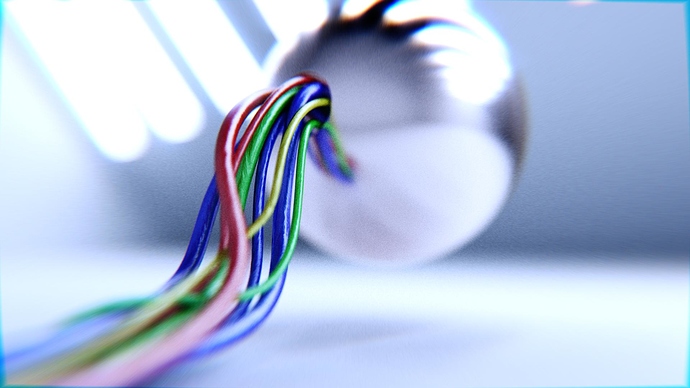Im working on a project where i’ll make some kind of robotic eye. I started by creating some cables, and here’s what i’ve come up with. What do you think? 
Very nice! Did you place them all by hand as curves?
Yeah, all the cables are curves placed and formed by hand. I was thinking about using some kind og physics, but i figured i got it more like i wanted if i did it by hand.
I’ll post a few pictures of the curves, and some wires, when i get home
I made this album to show you some wires and AO. This images is rendered with few amples and in a small size, and i don’t like the lighting either, but its something

My problem with laying curves like this is that they’re so hard to move around later if/when you want to add dynamics or animation to your scene. I guess Blender isn’t very good at applying physics to curves though? The only way I’ve figured out for that is hooking physics’d meshes to curve handles, which gets super tedious (but maybe less tedious than laying them by hand!).
Any idea yet what your cables will hook into on the other end? Robo-brain?
I will try to experiment with some physics later today, but physics in blender is something i usually avoid as i feel it’s to glitchy, and not very reliable.
The cables are not connected anywhere yet, but i’m thinking i will connect the cables kind of like this; http://i1.theportalwiki.net/img/thumb/7/79/GLaDOS_P2.png/400px-GLaDOS_P2.png
In that case i’ll have to practice som hard-surface-modeling.
Neat. I like the cables used as the optical nerve.
I like the cables used as the optical nerve.
I think having that one yellow cable was a fantastic idea!
It breaks up the scene and gives a great point of focus without disrupting the other elements.
I defiantly want to see where this goes!
This is neat so far.
Might be interesting to try making an armature first, then make a curve used for a wire with the same amount of control points as the number of bones in the armature. Duplicate that curve a few times. Edit the wires along the armature to interweave in a way that looks interesting. Then hook the points in each of the curves to armature bones in the same order. (Might have to do something to adjust offsets if if not kept. I don’t do this often enough to be sure.) The way I picture it is they’d still stay fairly bundled in the way it’s originally setup, but would flex as a group and follow the armature as it’s adjusted. Might even be better to do some intermediary type step using a spline armature, but I’m just thinking of something relatively quick for a basic test first.
If you don’t beat me to it, it’s something I’ll have to try testing out… (Rendering some other random thing at the moment.)
I’m very inexperienced with armatures, but I just managed to make pauljs75_'s work. To recap:
- Make an armature
- Make a curve through the armature, with a control point at the centre of each bone
- Hook each curve point to its bonea. Object mode -> Select the armature
b. Edit mode -> Select the bone
c. Object mode -> Select the armature then shit+select the curve
d. Edit mode -> Select the control point
e. Ctrl+H -> Hook to Selected Object Bone
f. repeat 3a-3h for each bone/point pair - Duplicate the curve a few times, but don’t move them
- Position the wires in edit mode, (for ever and ever… I find this so difficult!!)
Would it be worth me posting my .blend file?
I’m busy with an assembly-line robot arm rig, this technique could be very handy for them wires, I would love to have a look at your blend file please.
The wires aren’t carefully laid (I suck at using them curves) but I think it gets the point across.
Attachments
wires.blend (552 KB)
If you want it to be riggable, I suggest making a straight bundle of wires (as in, the wires are twisty, but as a whole the bundle goes straight), convert them all into a single mesh, and then use the curve modifier to control all the wires as a unit.
This video shows an alternative to armatures using the cloth simulation to control a mesh, hooked to a curve: https://www.youtube.com/watch?v=4ANT5vf5H-Y if you used the curve as a modifier to control your wire bundle, you might be able to get something pretty natural. You might need to learn the basics of animating keyframes if you’ve never done any, but that’s pretty straightforward.

